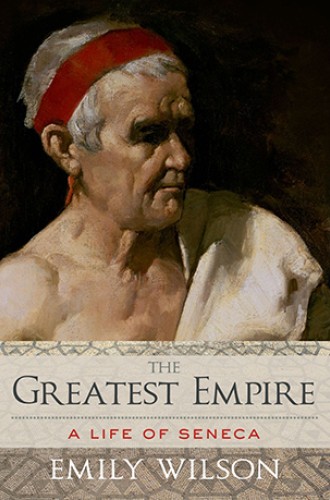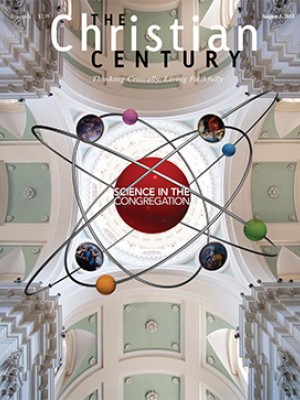The Greatest Empire, by Emily Wilson
Among world-historical dates few are of greater consequence than January 16, 27 BCE. On that date the Roman Senate gave the title of princeps to Gaius Octavianus (Caesar Augustus)—the adopted son of Julius Caesar. The declaration marked the final collapse of the ancient Roman Republic—a decline that had begun in 49 BCE when Julius Caesar crossed the Rubicon and established himself as dictator de facto over the affairs of state.
Lucius Annaeus Seneca, the subject of this sprightly biography by Emily Wilson, was born into this history, a narrative that begins in imperial Augustan splendor and descends into murder and madness in the reign of Nero. Seneca would become Nero’s early tutor and ultimately his victim.
Read our latest issue or browse back issues.
Seneca was a provincial, born sometime between 4 and 1 BCE in Corduba in Hispania. He was named after his father, Seneca the Elder, a wealthy member of the Roman equestrian class, which Wilson characterizes as “lower-upper-class.” (Roman society had no middle class; a few were rich, a multitude were poor.) In about 5 CE Seneca the Younger was sent off to Rome to acquire the manners and education proper to his class. Plagued by ill health, probably asthma, he spent a long period, from 16 to 31 CE, in Egypt. Upon his return he attained the position of questor, the first step on the traditional Roman cursus honorum. Seneca’s subsequent career and literary works would be shaped by imperial politics and whim.
Seneca chafed under the reign of Tiberius, whom he characterized as “horribly unkind,” and under his successor, Caligula, he was spared execution only because the emperor believed that ill health would cause his early death. (The reason for the emperor’s dislike appears to have been a speech Seneca delivered in the Senate, the content of which is unknown.)
Under Claudius, who became princeps in 41 following the assassination of Caligula, Seneca was banished to the island of Corsica for the presumed offense of adultery with Caligula’s sister, Julia Livilla. In 49 the situation was reversed when Claudius’s fourth wife, Agrippina, had Seneca recalled to serve as tutor for her son, Nero. At the death of Claudius in 54, with the connivance of Agrippina and the Praetorian Guard, Nero was proclaimed emperor instead of the legitimate heir, Claudius’s older son, Britannicus.
Seneca served the underage emperor as a speech writer, and later, along with Burrus, head of the Praetorian Guard, he helped Nero satisfy some of his more unsavory desires. Dealing with Nero’s erratic behavior finally became too much. Seneca begged the emperor to allow him to retire to his country estates to pursue philosophy. Nero denied the request, declaiming that the absence of such a wise counselor would reflect badly on his imperial person. In 65 a plot to assassinate Nero was discovered, to which Seneca may have been connected. The emperor no longer had any use for his old tutor and ordered Seneca to commit suicide. That act was accomplished in a dramatic scene described by Tacitus.
The biography of anyone who inhabited the corridors of power during those turbulent times would make fascinating reading. Wilson offers a carefully balanced narrative of Seneca’s life that is derived, as it must be, from partial and often contradictory sources, including Seneca’s own not wholly trustworthy descriptions of events. Wilson emphasizes that “Seneca would be an important figure in cultural and intellectual history even if he had not been so closely attached to the court of Nero.” It is Seneca the Stoic philosopher and author of nine blood-curdling tragedies who has compelled the interest of subsequent ages.
Over the centuries, interpretations of Seneca’s life and literary efforts have been as puzzling as the Seneca of Wilson’s biographical study. In what sense was Seneca a Stoic? His writings are generously eclectic; he borrowed from the Epicureans, from the Cynics, and ultimately from Plato. In what sense was he a philosopher? His father, Seneca the Elder, has come down to us—somewhat misleadingly—under the title “Seneca the Rhetorician” on the basis of two works he composed in old age, Controversiae (legal argument) and Suasoriae (hortatory discourse). When Seneca the Younger came to Rome, he did not study philosophy; like his father he studied rhetoric. Philosophy in Rome had a rhetorical direction lacking in the more theoretical cast of the philosophy of the great Greeks or of modern academic philosophy. The rhetorical cast of Seneca’s work is everywhere present. Even in his late Naturales Quaestiones, Wilson notes, “metaphors of politics are used to discuss physics, and conversely physics is described in terms that constantly revert to Seneca’s moral and political themes.”
Only those of wealth and station like Seneca received advanced education. It was expected that they would seek a career in public life for which rhetoric, the art of persuasion, was an essential skill. By the time of Seneca, however, imperial edict had preempted political debate, so the traditional purpose of rhetoric collapsed. Wilson describes the situation:
Elite Roman men [had to speak] . . . in a political system that robbed them of the old kinds of power. They constantly spoke and wrote in a kind of double-speak . . . that could always be interpreted in more than one way, . . . a bombardment of the most “truth-y” kind of sentence. . . . Rhetoric was not only a style, but a way of being in the world.
If rhetoric in the days of the Roman Senate fostered political debate, rhetoric under the imperium—particularly under Nero—flattered the emperor. Seneca followed suit: “You, Caesar, have given us a state unstained by blood.”
While this was scarcely so even at the beginning of Nero’s reign, Seneca may have hoped his youthful charge would grow into the benevolent image. As Nero passed beyond tutelage, Seneca passed beyond hopeful flattery. Tiring of his wife, Octavia, Nero was determined to marry Poppea, but his mother, Agrippina, was adamantly opposed. To satisfy Nero, Seneca apparently helped arrange the death of Agrippina. As if that were not bad enough, he then composed a letter to the Senate in Nero’s name justifying the action on the basis of a spurious charge that she was planning to assassinate the emperor. Wilson notes, “Even in a world where dissimulation was the norm, . . . Seneca had gone too far. . . . People were more outraged by Seneca than by the barbarous Nero, at whom there was no longer any point of being shocked.”
The title of Wilson’s study, The Greatest Empire, is derived from a passage in one of Seneca’s epistles in which he contrasts “those who attempt to conquer the world and attain political power . . . to those who manage to achieve an empire of control over themselves: imperare sibi maximum imperium est (‘The greatest empire is to be emperor of oneself’).” In an age when external politics was irrational, Seneca turned to the inner self.
But why, having denigrated political power in the light of Stoic control, did Seneca lead such a very public life, engaging in rhetorical flimflam and being an apologist for murder? His younger brother Mela actually lived an interior life, withdrawing completely from public office. The contrast between Seneca’s public life and his literary life extolling high virtue raises him to a position of exalted hypocrisy. Seneca admired the Cynics’ radical rejection of wealth, but he was immensely wealthy, worth about 300 million sestertii in a day when a legionary in the army earned 900 sestertii per year. He envied the Epicurean retreat to the simple life, but hosted banquets on his estates in which he sat guests at 500 specially constructed tables with ivory legs. If you live an interior life in the “empire of the self,” you may discount external dirty politics as irrational illusion, not to be taken seriously.
Because rhetoric is the art of persuasion, Seneca studied human passions and how to shape them. His analyses are acute and have been much admired. His literary style is more controversial. Quintilian regarded it as “unnatural” and a bad influence on the young. T. S. Eliot seemed to echo that view when he criticized Senecan tragedy as “bombastic” and “rhetorical” in the wrong way.
Seneca and Jesus were almost exact contemporaries. Seneca’s older brother, Novatus, called Gallio, turns up in Acts as the proconsul who dismissed charges that a local Jewish community had brought against Paul. This minor event led some to believe that Seneca had corresponded with Paul, and a set of spurious letters composed probably in the third century suggests as much. Seneca’s protracted suicide ended in his being smothered in a hot bath, which some Christians believed was his baptismal font. St. Jerome placed him “in the company of our saints.”
The notion that Senecan Stoicism influenced the development of Christianity has also been advanced. Seneca’s philosophic rejection of wealth and power, of the empires of the world as against the empire of the spirit, seemed to fit the preaching of Paul.
In the long run, however, Augustine’s critique of Seneca is correct. Seneca’s “empire of the self” isolates humanity from grace and love. Senecan rhetoric, so measured and so polished, misses our stammering before God.







